Puritan Plain
- Reference:
- “If ever two were one, then surely we.
- If ever man were loved by wife, then thee” (Bradstreet, 1678).
- Effectiveness/Significance:
- Conveying complex emotions through simple wording;
- Clear and accurate articulation of the key idea;
- Focus on the topic (mutual love and support);
- Lack of embellishments: emphasis on the message;
- Result: an emotionally convincing piece.
- Example:
- “The Universe is mostly empty and cold.”
- Commentary:
- Use of one- and two-syllable words;
- Short, simple sentences and phrases;
- Complex ideas expressed plainly;
- Accurate use of the puritan plain;
- Significance for the analysis: high (precise example).
The concept of a puritan plan is typically expected to help to contrast the simplicity of the word choice with the emotional weight of the text. Therefore, the significance of the technique is quite high since it allows to juxtapose the emotional tension of the text to the simplistic manner of relaying it. In addition, the absence of additional embellishments establishes a specific mood that can be characterized as highly sincere and trusting, which leads to an increase in the reader’s emotional engagement.
The excerpt above represents a clear case of a puritan plain since it uses a very basic vocabulary to render its message while retaining its weight and complexity. As seen in the example above, the poem does not feature any words that may have several denotations, nor is any of the words colored by a specific connotation. Moreover, Bradstreet (1678) avoids long words or phrases, preferring shorter ones. Therefore, the example above represents the phenomenon of a puritan plain.
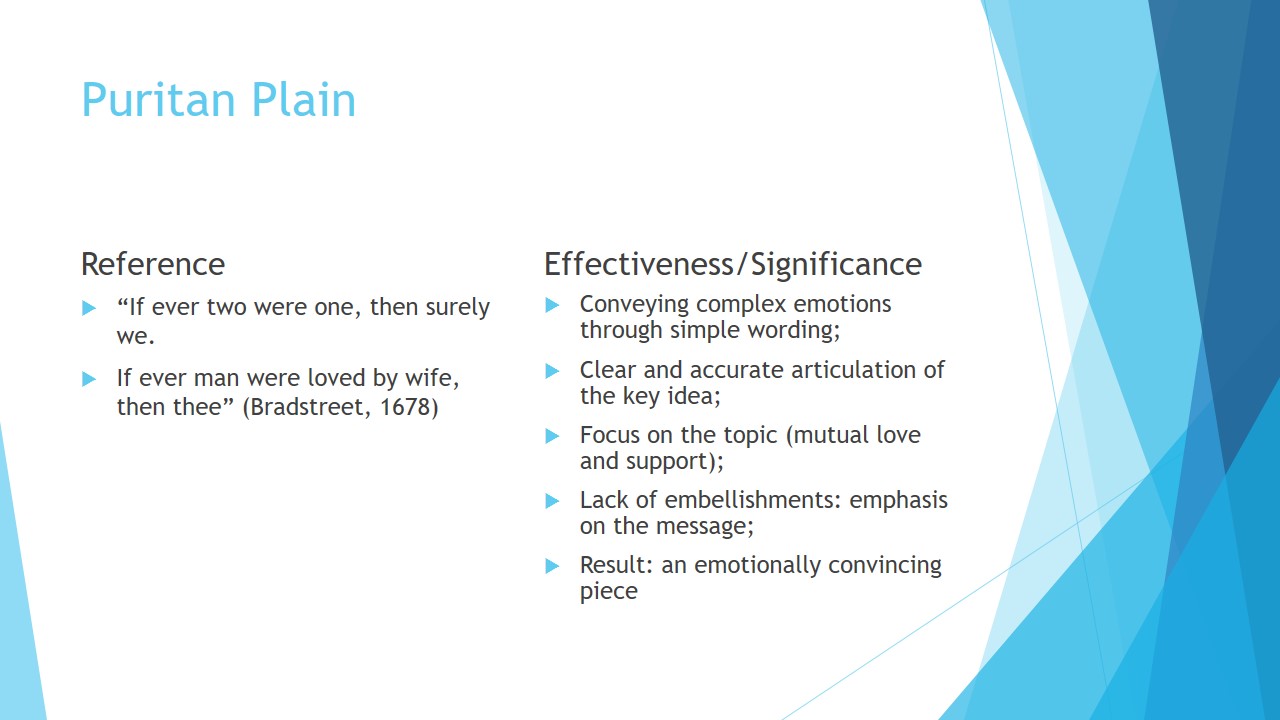
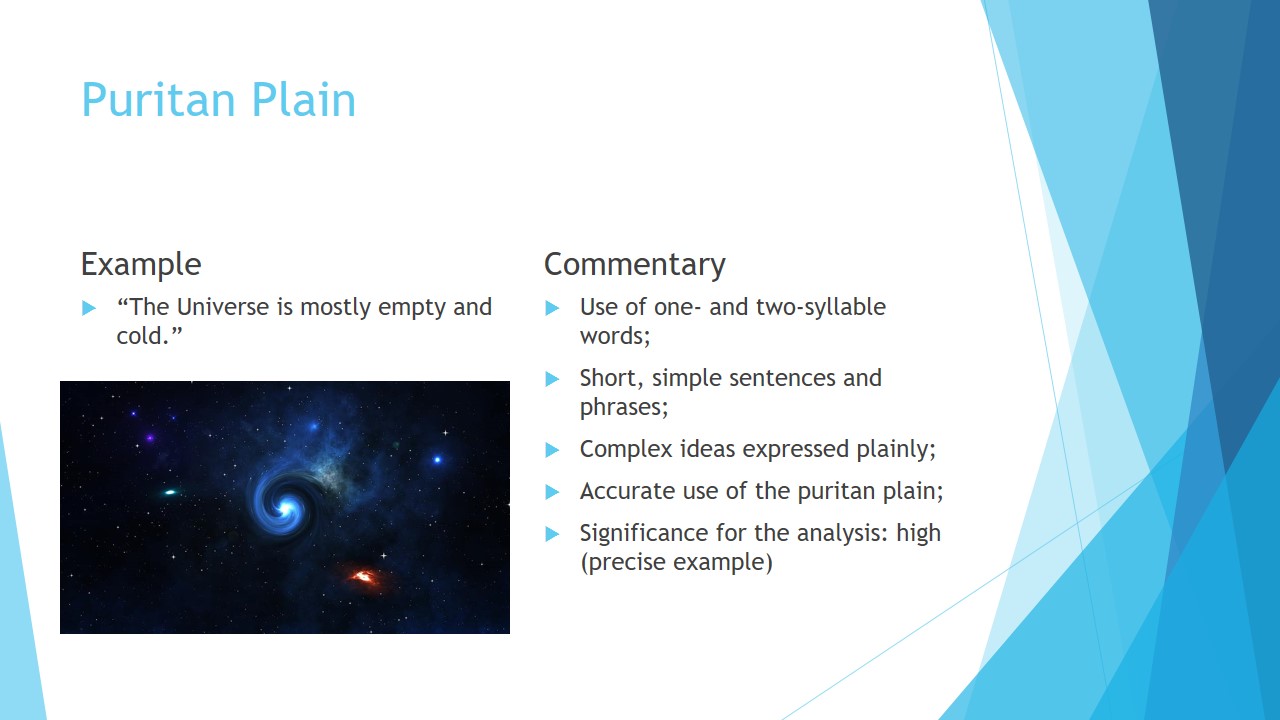
Archaism
- Reference:
- “Of Plymouth Plantation Excerpt”: a work by William Bradford;
- Focus: the colonization of North America;
- Interpretation from the perspective of an actual settler;
- Mostly represented by the Modern English in its current form;
- However, containing multiple archaic words and phrases.
- Effectiveness/Significance:
- Creating a stylistic reference to a different time period;
- Adding a unique flair to a message or a character;
- Setting the tone for the general narrative;
- Developing an appropriate atmosphere in the work;
- Focusing on the historical significance of the theme.
- Example:
- “This person’s life was shrouded in mystery.”
- Commentary:
- “The ship was shroudly shaken” (“wickedly”) (Bradford, 1630-1650);
- “A desperate and inevitable peril” (“danger”) (Bradford, 1630-1650);
- “They thus lay at hull” (“drifted”) (Bradford, 1630-1650);
- “Seeing them resolute” (“resolve”) (Bradford, 1630-1650);
- “They were soon quelled” (“suppressed”) (Bradford, 1630-1650).
- Presence of lexico-semantic archaisms: “quelled” (Bradford, 1630-1650);
- Use of grammatical archaisms: “I shall” (Bradford, 1630-1650);
- Biblical references: “Like men from Eshcol” (Bradford, 1630-1650).
The concept of archaism is fairly simple as it implies the presence of any word that is no longer in use. The application of archaisms allows referring to a particular epoch or adding an emotional coloring to the discourse, thus creating a specific atmosphere. Typically used to outline an old-fashioned concept or character and create a poetic tone, archaisms serve their function quite well.
Although the example at hand is ripe with archaisms, it might seem questionable whether the vocabulary used in the poem can be termed as such given the year when it was published. Despite the fact that the words such as “quelled” are admittedly archaic nowadays, they were quite common at the time when the poem was written and did not contain the stylistic reference that they do nowadays. Nonetheless, from the contemporary perspective, the example above is filled with archaisms, which set the poem in a very specific time frame and add an appropriate atmosphere to it.
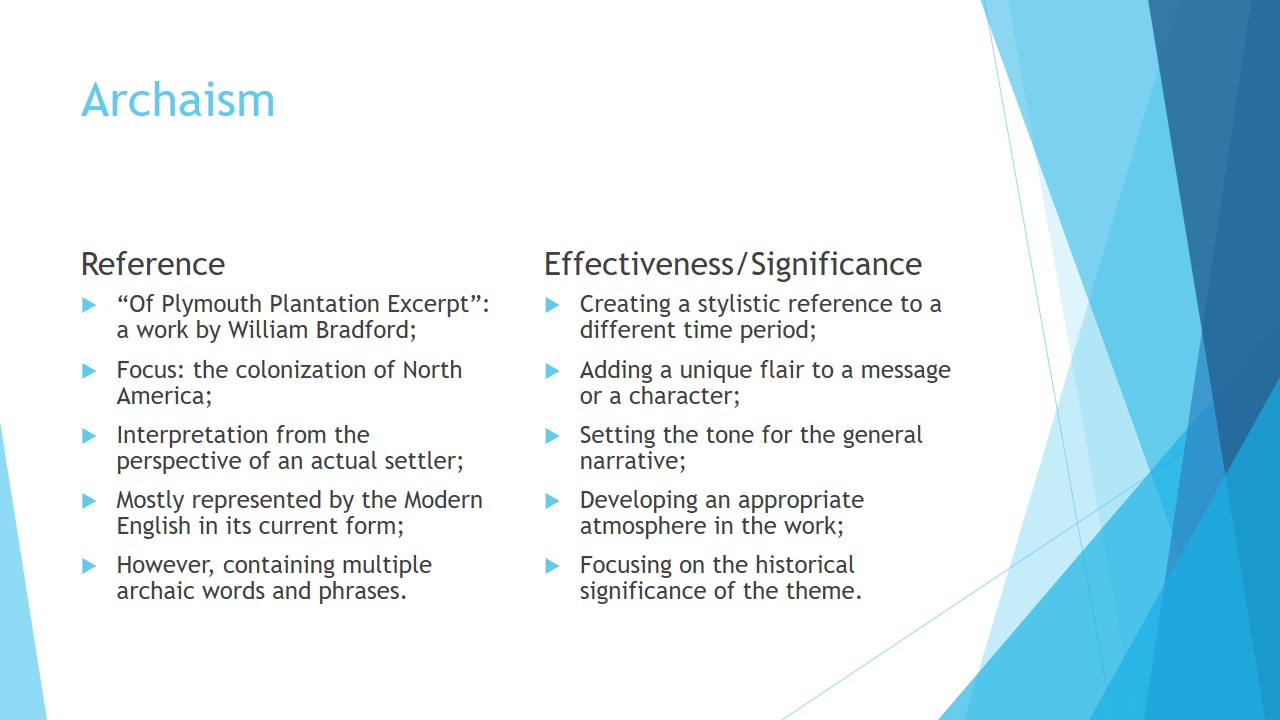
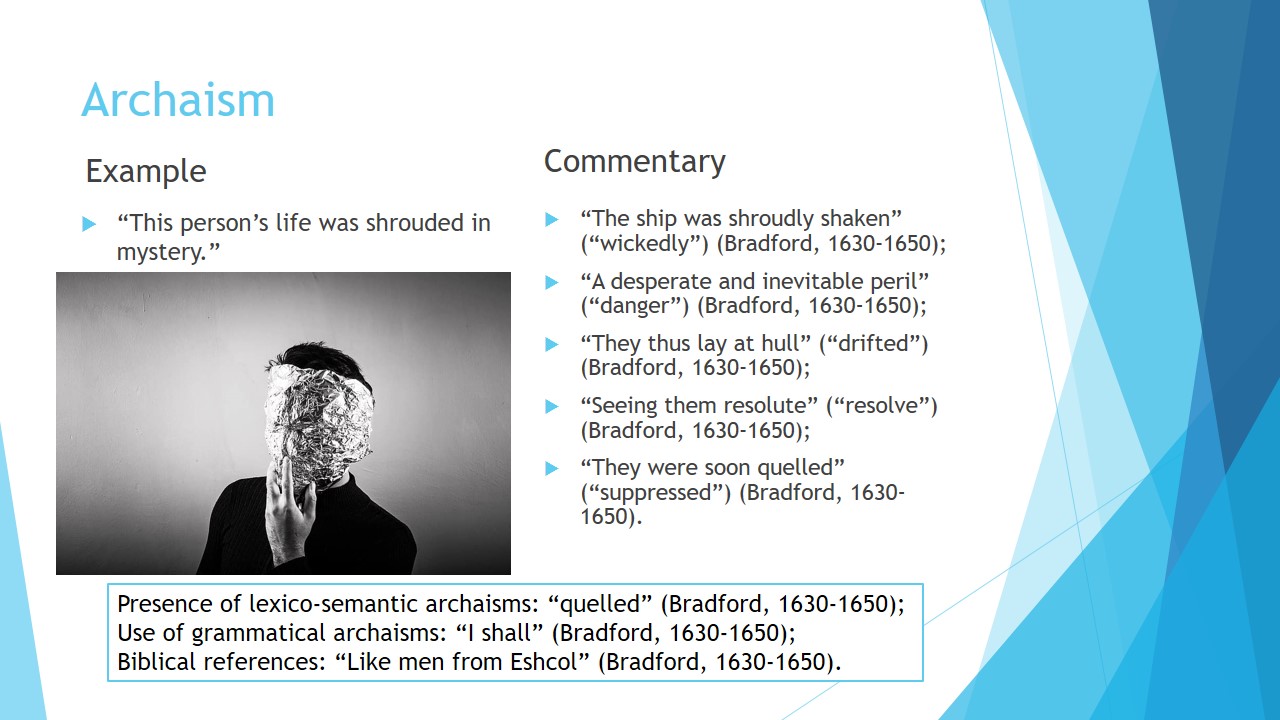
Allusion
- Reference:
- Allusion: a reference to a well-known character, item, or phenomenon;
- “‘And he said unto me, my Grace is sufficient for thee’ (2 Corinthians 12.9)” (Rowlandson, 1682, 3);
- “Oh the doleful sight that now was to behold at this house! ‘Come, behold the works of the Lord,
- what desolations he has made in the earth.’” (Rowlandson, 1682, p. 3).
- Effectiveness/Significance:
- Support for a reader: a familiar emotional experience;
- Opportunity to introduce a well-known symbol;
- Appeal to a wide audience by using a cultural proxy.
- Example:
- “When we finally reached the city, it felt like we were in our personal Utopia.”
- Commentary:
- Focus on the existential turmoil of the protagonist;
- Appeal to the spirituality of the readers;
- Use of one of the most famous texts;
- Implied plight for salvation.
The notion of allusion suggests referring to a specific concept, idea, phenomenon, or person without naming them directly. The described approach is particularly helpful when creating a nuanced, multi-layered narrative with hidden underlying meanings. However, a simpler work may also utilize allusions as the way of helping a reader to relate to the text and characters closer by introducing a familiar emotional experience.
The application of an allusion in a poetic or prosaic work allows the reader to delve into the emotional change that the main character undergoes, as seen in the “Narrative of the captivity and restoration of Mrs. Mary Rowlandson.” By alluding to Biblical verses, the author appeals to the emotional and spiritual experiences of her Christian readers. As a result, the narrative allows establishing a powerful rapport between the reader and the author.
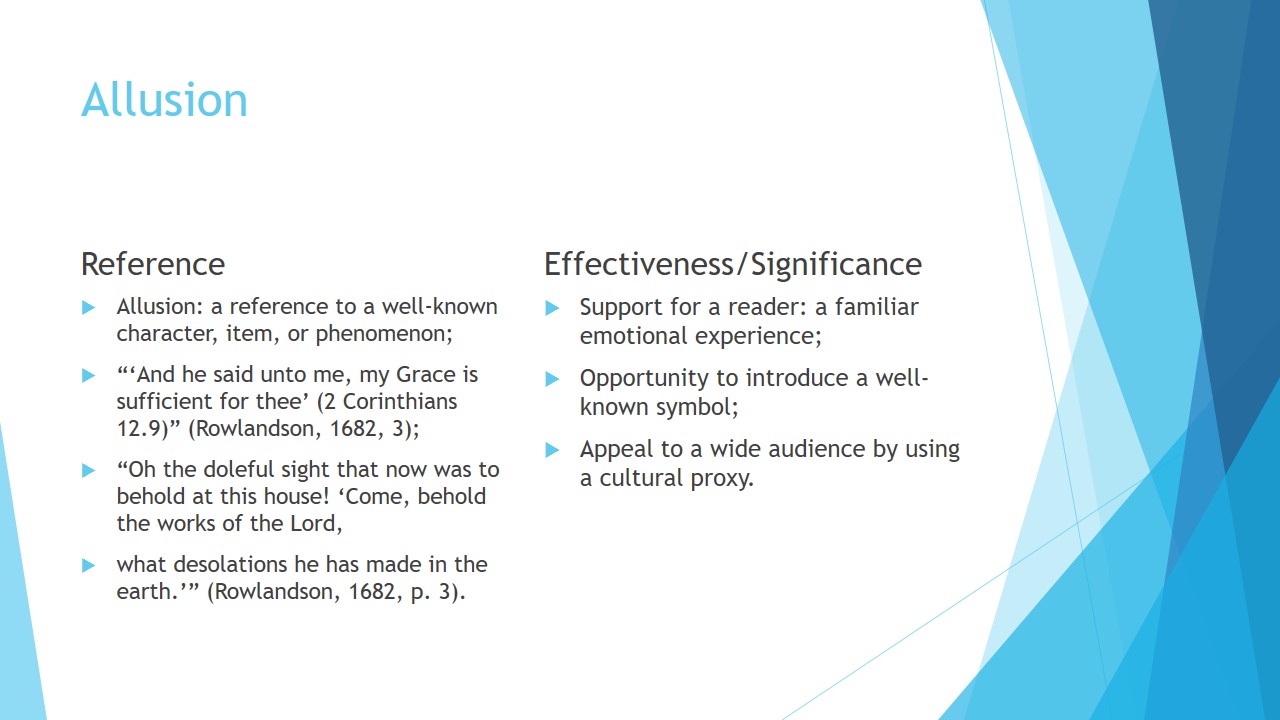
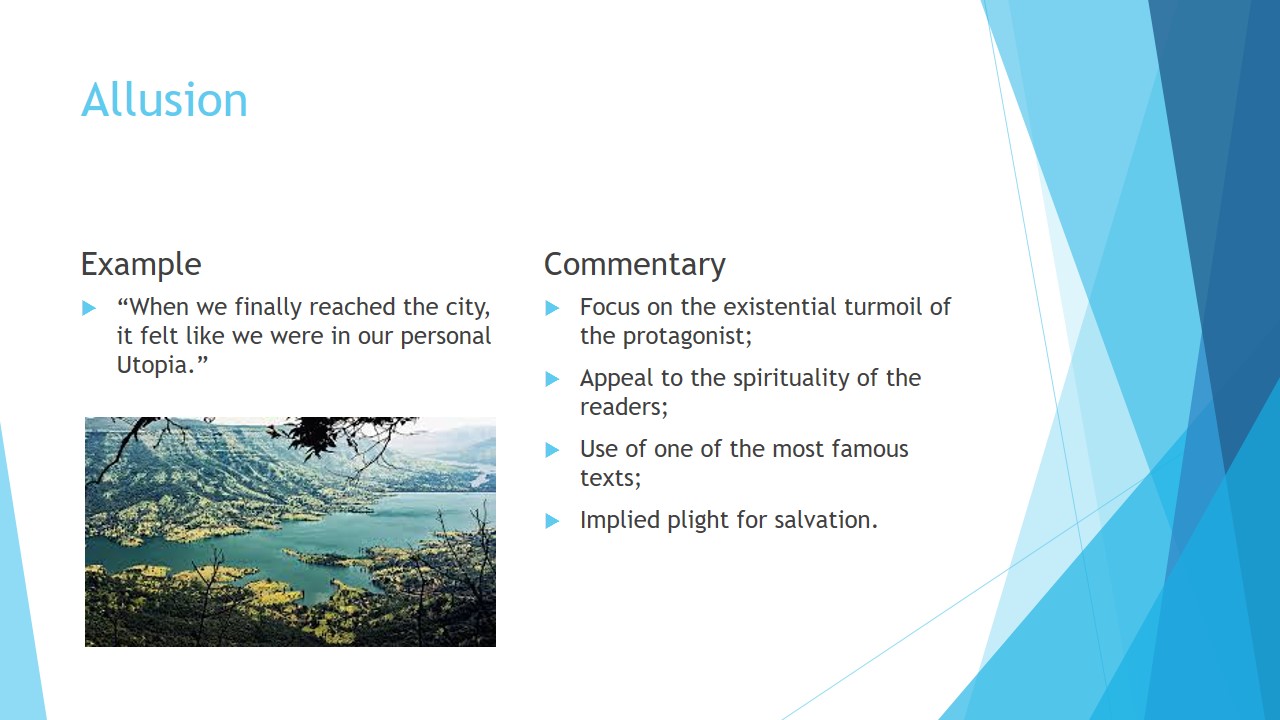
Exhortation
“Your wickedness makes you as it were heavy as lead” (Edwards, 1741, p. 1);
“Your destruction would come like a whirlwind” (Edwards, 1741, p. 2);
“It would be nothing to withstand or endure it” (Edwards, 1741, p. 2).
- Reference:
- Text: “Sinners in the Hands of an Angry God”
- Author: Jonathan Edwards, Rev.
- Text type: sermon.
- Year: 1741.
- Key concepts: redemption, sinful human nature, need for spiritual growth.
- Effectiveness/Significance:
- Opportunity to amplify the seriousness of the message;
- Introduction of a solution to the ethical issue;
- Promotion of change in behaviors and attitudes;
- Possible issues: inefficacy due to obtrusiveness;
- Main opportunities: introduction of a positive change.
- Example:
- “Fear not! The help is almost here.”
- Commentary:
- Warning about the threats of incompliance;
- Promotion of piety and following the established line of behavior;
- Outlining key negative characteristics that must be eradicated;
- Exhortation as a tool for preaching and the focus on control.
Another important literary device, exhortations is a variety of persuasive speech. The specified tool is widely used to purport the sense of urgency and to prompt an action from the reader. The significance of exhortation as a literary device is quite high since it establishes the stakes in the narrative, simultaneously amplifying the emotional tension within a discourse. The creation of an impetus for change that the specified device provides is central to the development of a persuasive speech, which is why the use of an exhortation is still relevant in modern literature. Nonetheless, exhortations can be found as early as the Middle Ages, as the text under analysis indicates.
Due to the didactic nature of an exhortation as a literary device, it is most likely to be found in a sermon. Therefore, considering the “Sinners in the Hands of an Angry God,” an 18th-century sermon written by the Rev. Jonathan Edwards, appears to be the most suitable example to cite. Indeed, focusing on the necessity to restore virtue and morality in the community, the sermon incorporates quite a number of cases of an exhortation. From the perspective of a contemporary reader, the example above might seem as slightly naïve, yet it captures the nature of an exhortation perfectly.
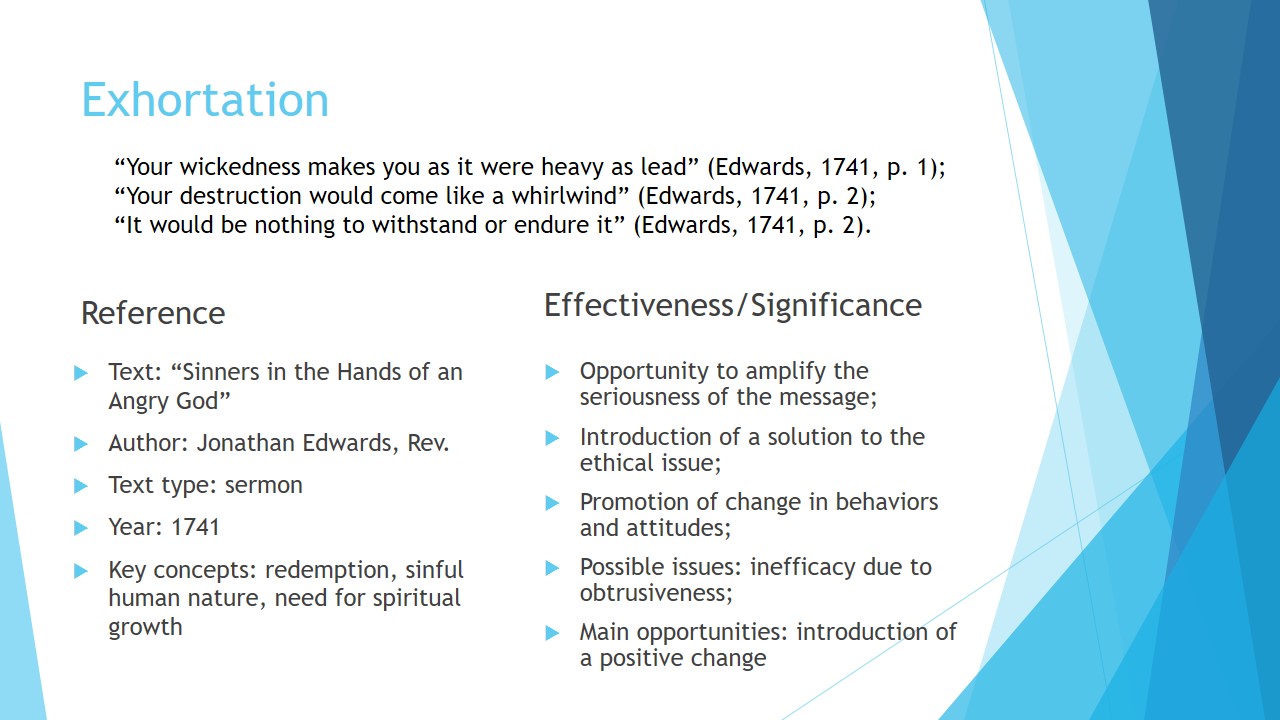
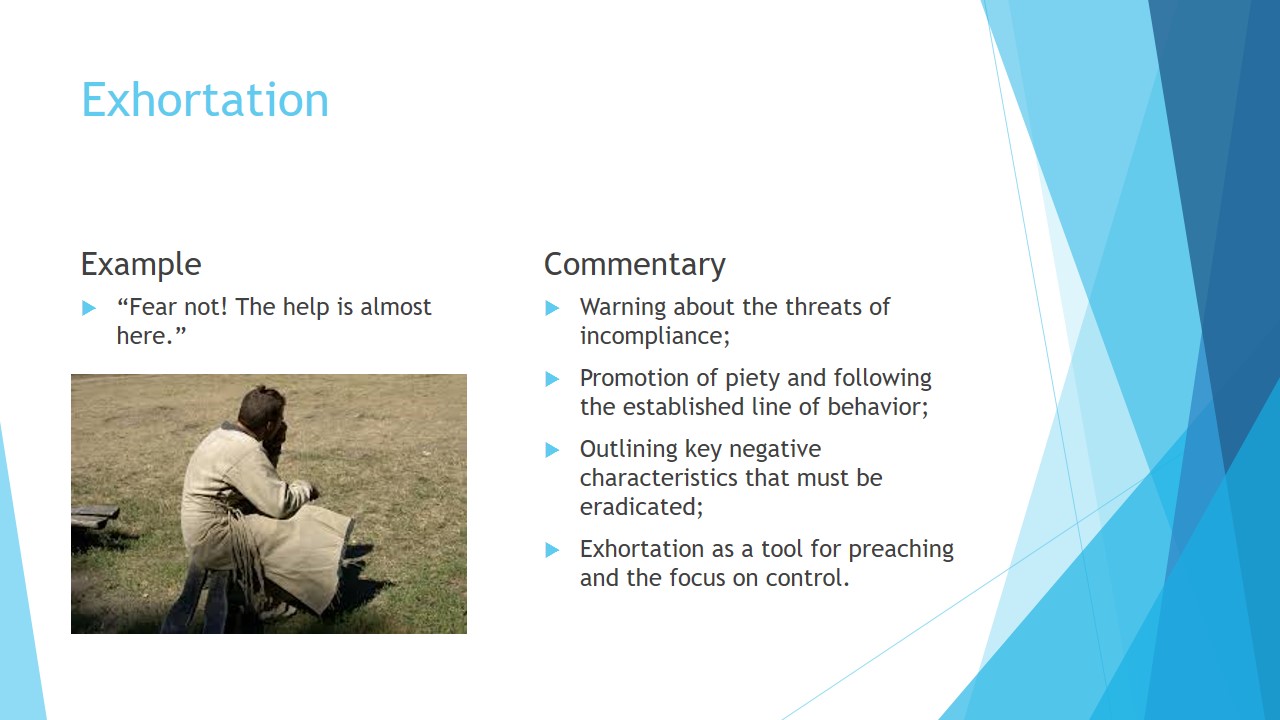
Inversion
- Reference:
- “Upon the Burning of our House” by Anne Bradstreet;
- “In silent night when rest I took,
- For sorrow near I did not look,
- I waked was with thund’ring noise;
- And piteous shrieks of dreadful voice” (Bradstreet).
- Effectiveness/Significance:
- Change in the tone and the seriousness of the message;
- Focus on the weight of the message delivery;
- Increase in the grandeur and pompousness of the style;
- Attempt at changing the pace to attract the audience’s attention.
- Example:
- “He did not say a word, nor did he move his head.”
- Commentary:
- Every line representing an inversion;
- Increase in the aesthetic and emotional impact of the poem;
- Creation of a ceremonious atmosphere;
- Focus on the seriousness of the message and its impact.
Implying the change in the traditional order of words, inversion is traditionally used to make a particular statement stand out. When used too frequently, inversion loses its impact, yet, when inserted into an orderly structured text, it makes a tremendous impact on the reader. The experience of reading a sentence that is completely misaligned with the rest of the text is quite striking despite the simplicity of the specified device. Allowing to change a tone toward a less formal and a more high-flown one, inversion is used as a tool for emphasizing specific ideas in a text.
While considering a poem as a source of examples for an inversion could be seen as cheating, the use of “Upon the Burning of our House” by Anne Bradstreet is still justified since the poem does not simply incorporate inversion. Instead, “Upon the Burning of our House” is nothing but inverted sentences and the use of inverted structures. At first, one might see the specified approach as a way of devaluing the emotional and aesthetic impact of an inversion. However, on further consideration of the poem, one will realize that it is supposed to represent a single emotional experience.
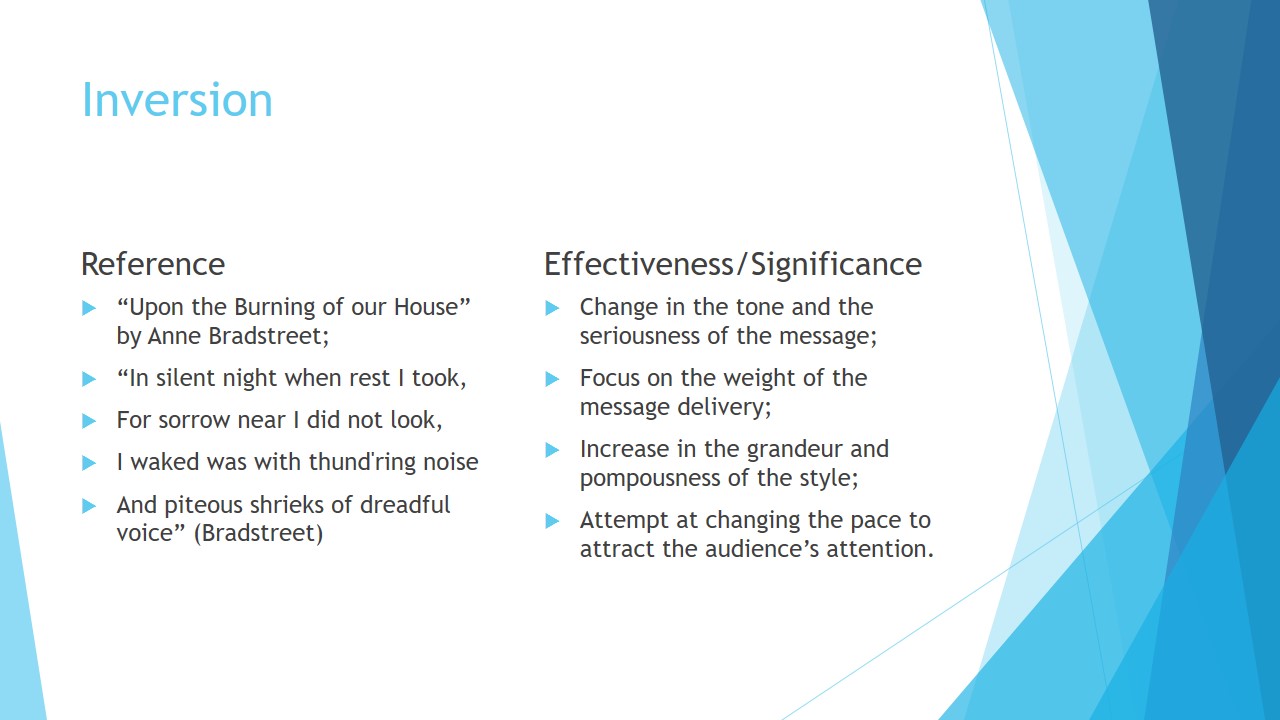
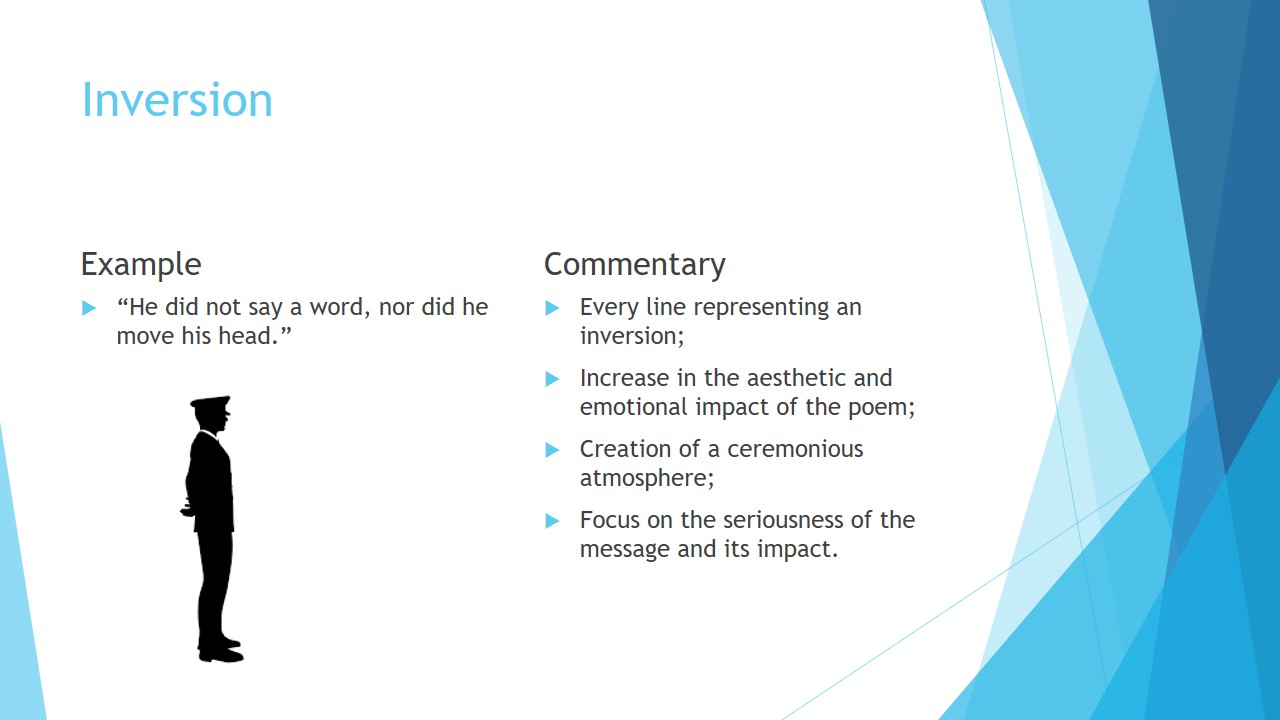
Anaphora
- Reference:
- Text: “City upon a Hill”
- Author: John Winthrop
- Year: 1630
- Effectiveness/Significance:
- Reinforcement of the message;
- Attraction of the audience’s attention;
- Creation of a rhythm for the audience to follow.
- “Wee must entertaine”;
- “Wee must be willing”;
- “Wee must uphold”;
- “Wee must delight”;
- “Wee shall finde”;
- “Wee shall be”;
- “Wee shall deale”;
- “Wee shall open”;
- “Wee shall shame” (Winthrop, 1630, p. 1).
- Example:
- “I see everything. I hear everything. I remember everything.”
- Commentary:
- Creation of a unique rhythm;
- Reinforcement of an idea;
- Promotion of group thinking.
Repetition holds a particular power in the range of rhetorical tools that one can use when developing a text. Anaphora represents a type of repetition that occurs at the beginning of sentences that form a consecutive sting. The use of anaphora allows for the impression of a cadence of sounds that create a certain rhythm, allowing the text to produce a greater impact on the listeners.
The use of anaphora as a literary device is quite common in poetry and other genres that require the creation of a certain rhythm in a narrative. Allowing a text to gain certain properties of a musical piece, namely, develop a specific rhythmic structure, anaphora is typically utilized to introduce an idea and reinforce its impact. Therefore, considering a sermon as the primary source of anaphora in a speech is entirely reasonable. In John Winthrop’s “City upon a Hill” written in 1630, the presence of anaphora helps to create a convincing text that encourages the audience to accept the promoted familial ties. The opening paragraph contains multiple “We Must,” whereas the middle retorts with multiple promises of “We shall” (Winthrop, 1630, p. 1).
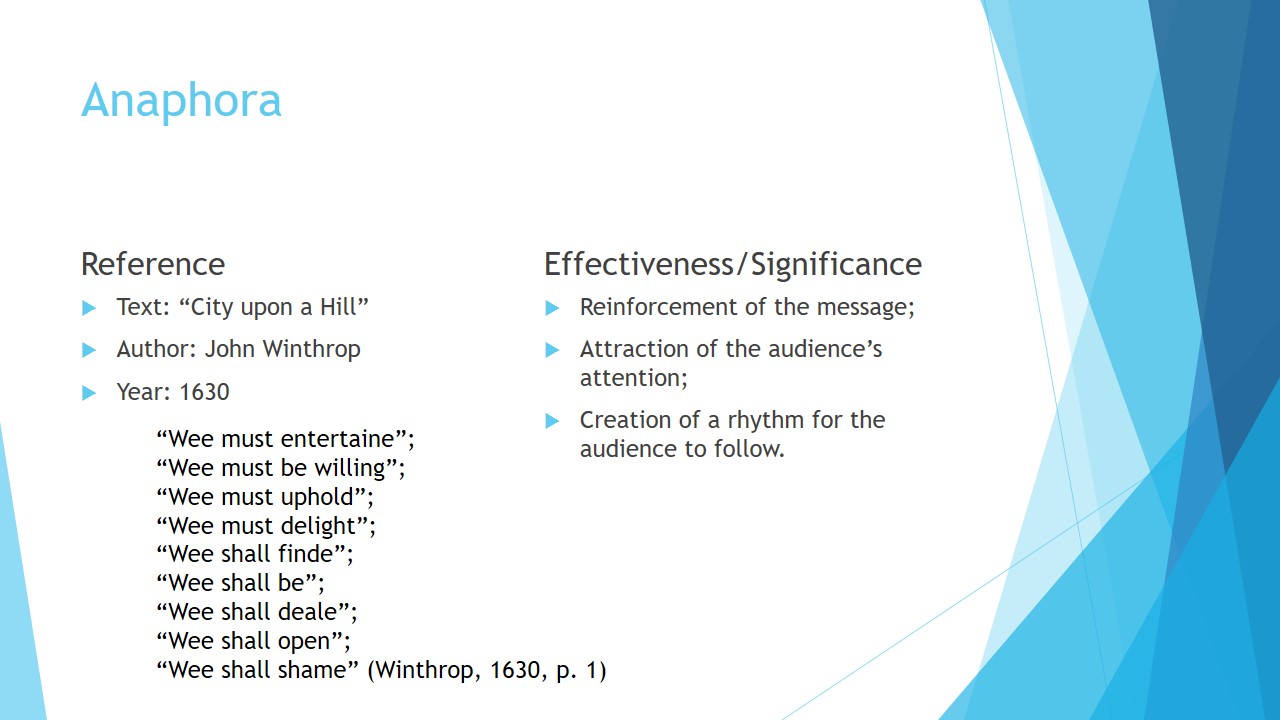
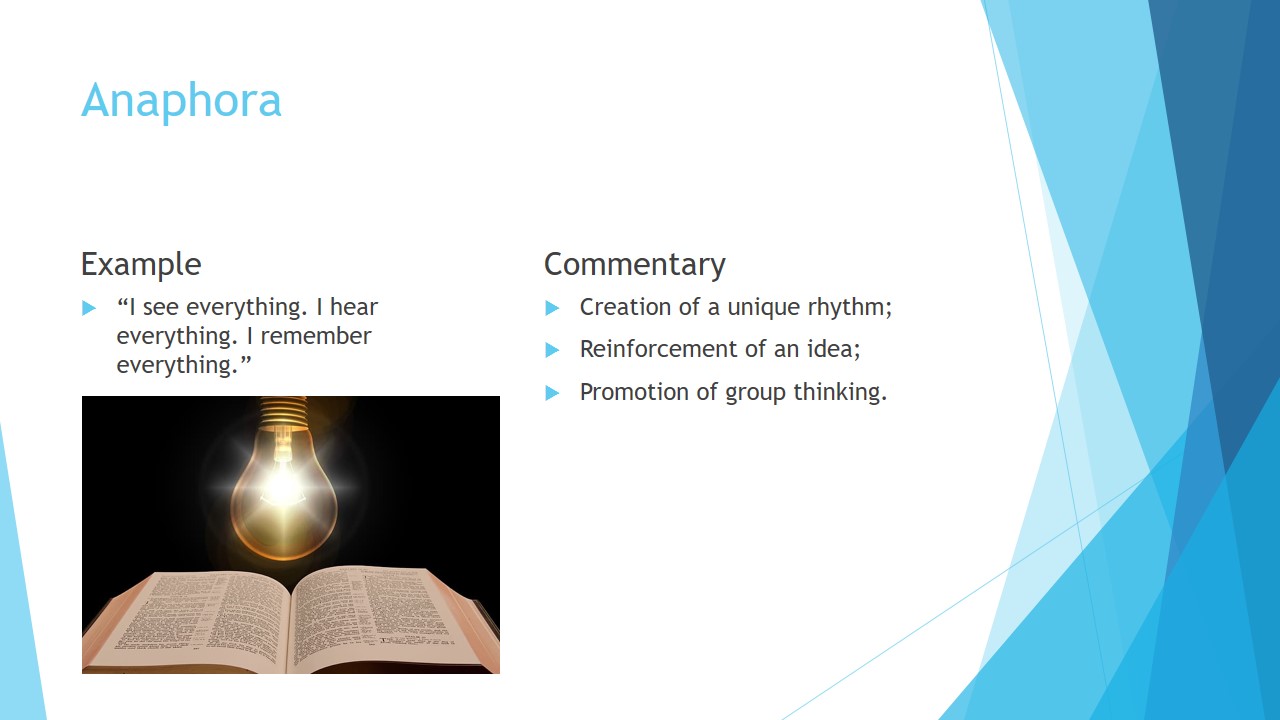
Conceit
- Reference:
- “The bullets seemed to fly like hail” (Rowlandson, 1682, p. 1);
- “Like a company of sheep torn by wolves” (Rowlandson, 1682, p. 2);
- “They, like inhumane creatures, laughed, and rejoiced” (Rowlandson, 1682, p. 3).
- Effectiveness/Significance:
- A conceit plays an important role in a text;
- it helps to create a complex idea and introduce multiple literary devices as a single unit;
- thus, the key characteristics of each are taken to produce an entirely new phenomenon;
- the specified effect allows drawing extra attention from the audience and creates an aesthetically pleasing impression.
- Example:
- “You are like a birthday present.”
- Commentary:
- Conceit: an important literary device;
- An attempt at merging two different devices;
- A tool for keeping the message unique and relatable;
- A way of stirring the audience’s imagination;
- A way of making a comparison more accurate.
Although the notion of conceit is quite often conflated with that one of a metaphor, it, in fact, is quite different from the latter. Conceit incorporates the principles of a metaphor and a simile, pushing each to its extreme. Namely, a conceit suggests comparing two objects, notions, or items that have nothing in common, and it does so by using metaphor. The inclusion of conceit in a text allows adding a unique flair to the message, amplifying the effects that both a metaphor and a simile produce.
The introduction of a conceit in a text often allows incorporating complex imagery and metaphors into it, thus developing a multilayer idea. The use of conceit contributes to the improvement in its quality once the metaphor and the simile utilized for this purpose are unique and original. However, when both are trite and well-trodden, the attempt at creating a compelling conceit falls quite flat, as shown in the example above.
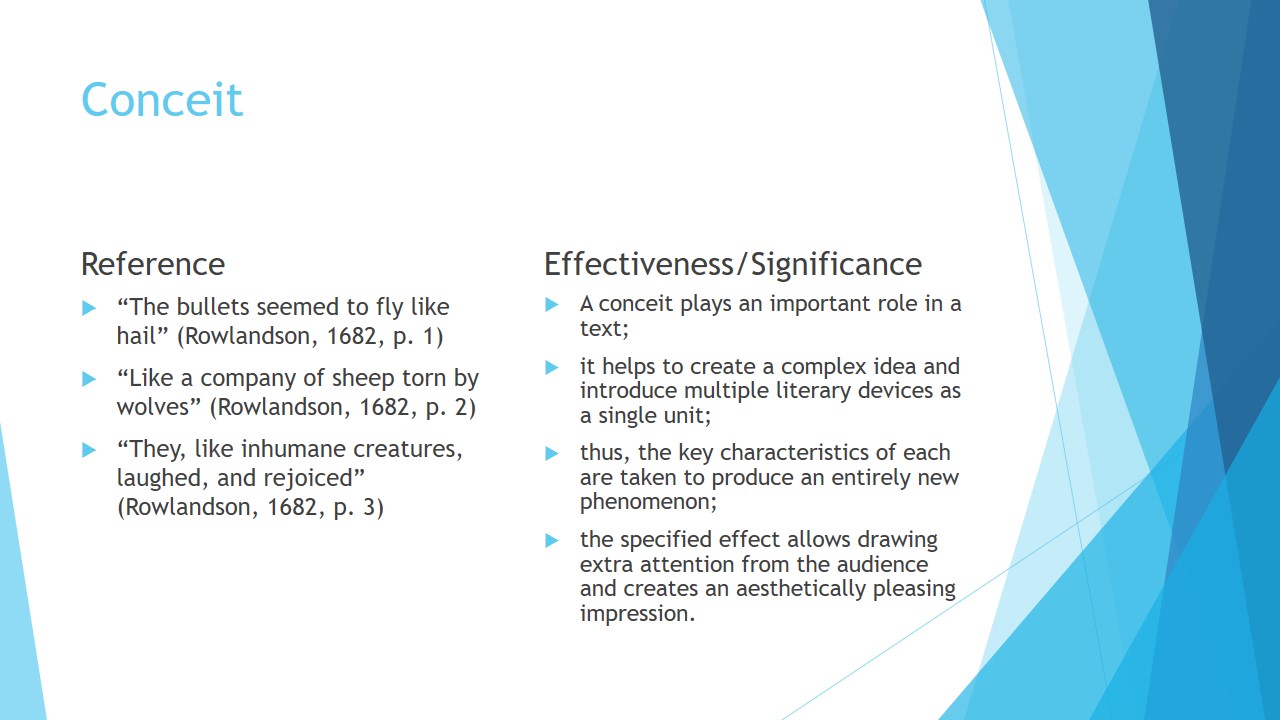
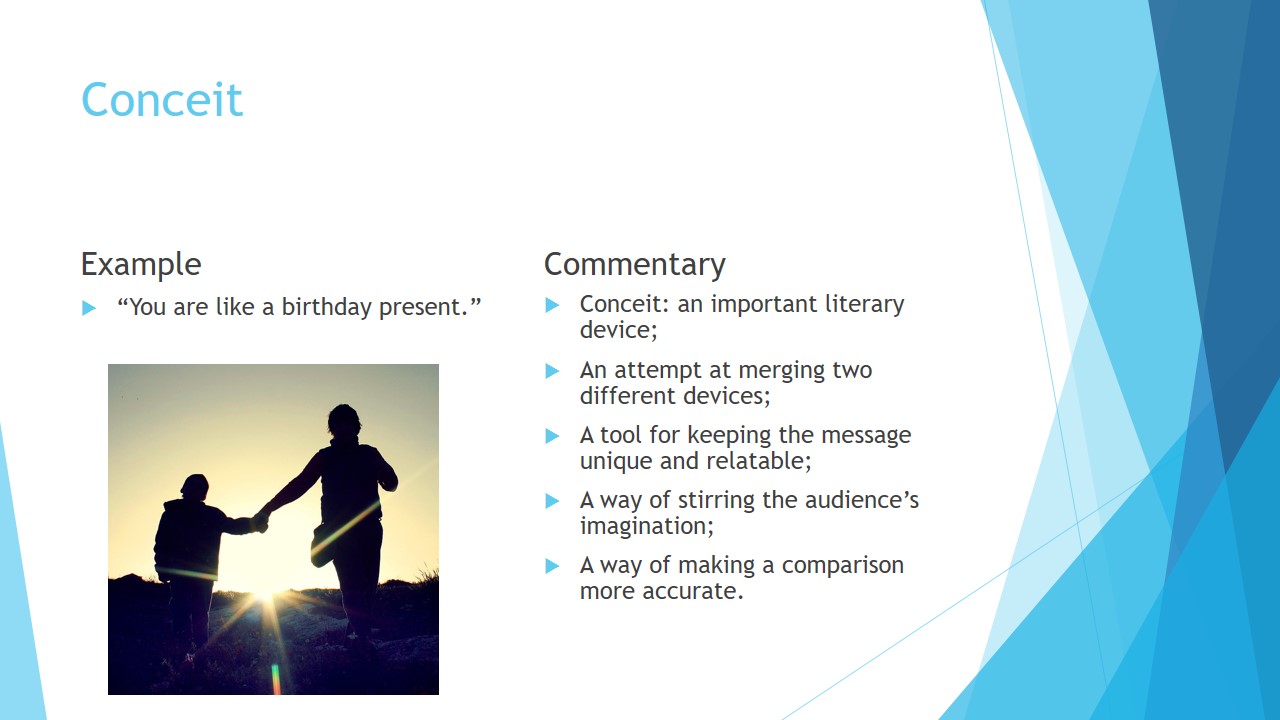
Apostrophe
- Reference:
- Text: “Huswifery”;
- Author: Edward Taylor;
- Year: 1685;
- “I blest His name that gave and took…/.
- In silence ever shall thou lie” (Taylor, 1685);
- Effectiveness/Significance:
- Change in the focus of the narrative;
- Shifting the emphasis from one of the agents of the discourse to another;
- Introducing a third party to the dialogue;
- Change in the tone and meaning of the narrative;
- Opportunity for introducing a meta-commentary to the text.
- Example:
- “I saw him right before he left. You, as the viewer, must have noticed it.”
- Commentary:
- Shift from the third person to the second;
- Change from the inner monologue to the dialogue with God;
- Transfer from a poem to a prayer.
The phenomenon of apostrophe in literature typically occurs when the main character interrupts the dialogue within the text and addresses a third party. The latter may be represented by a side character, an inanimate object representing a part of the scene, or even the audience. The latter occurrence has gained popularity recently and is currently known as breaking the fourth wall. Apostrophe allows changing the pace of the narrative and introducing certain elements of characters’ backstory, plot, and other aspects of the universe in which the action takes place.
The text above exemplifies the use of apostrophe s an attempt at changing the course of eh conversation within the narrative and introduce a new agent into the dialogue. As the piece in question proves, the use of apostrophe in the described context allows exploring the characters and understanding their needs and development within the story.
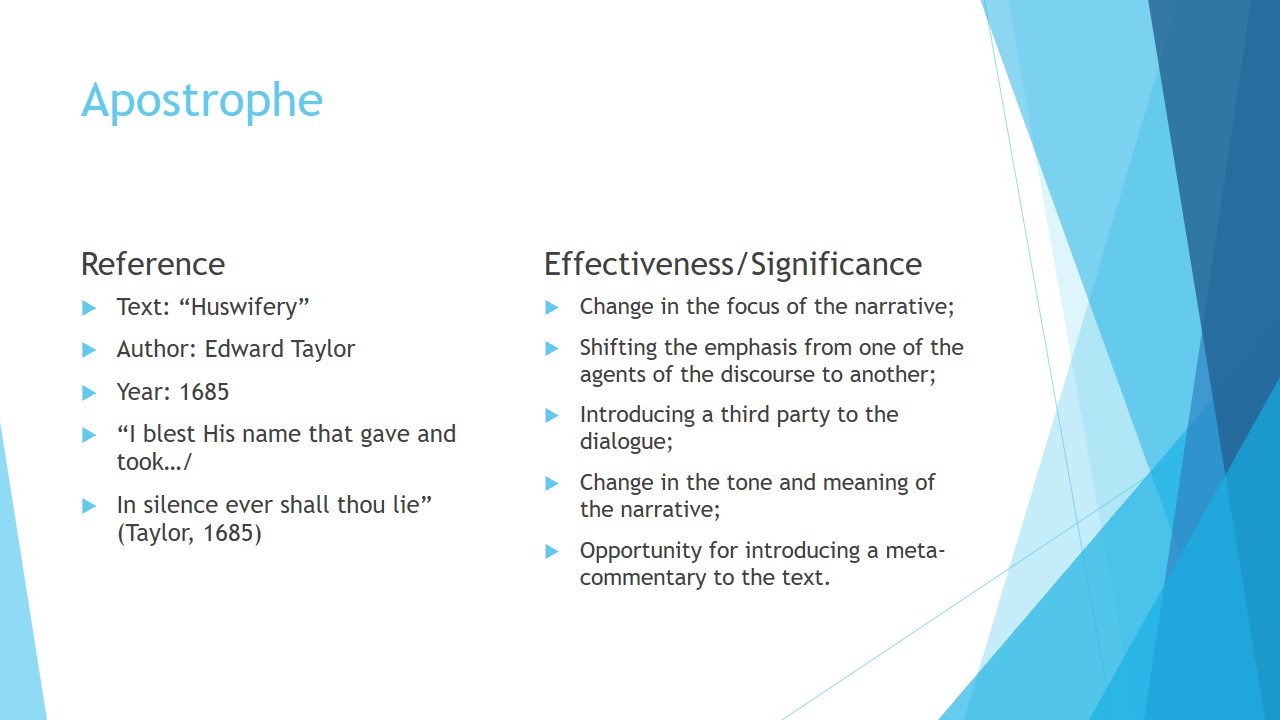

Metaphor
- Reference:
- Metaphor: a literary device allowing changing the literary meaning of a word;
- “Varnished flowers of paradise”; “make my soul Thy holy spool to be” (Taylor, 1685);
- “Then weave the web Thyself” (Taylor, 1685);
- “Then clothe therewith mine understanding” (Taylor, 1685);
- Effectiveness/Significance:
- Opportunity to introduce nuanced ideas;
- Creation of a symbolic representation;
- Opportunity to relate to the audience’s culture;
- Development of universally understood imagery
- Example:
- “I feel that I have reached the peak of my creativity.”
- Commentary:
- Introduction of double meanings to words;
- Substitution of meaning by comparison;
- Use of everyday items to represent larger notions;
- Shift from the mundane to the spiritual.
Being, perhaps, one of the best known and most widely used literary devices, a metaphor allows enriching a text with nuanced ideas and drawing unique parallels. Introducing a double meaning into a narrative, a metaphor can be used very broadly and may be applied to virtually any sentence containing any element of the narrative that does not align with the literal application of the word or phrase in question. Metaphors allow making a text less dry and adding the element of liveliness to it.
In the text under analysis, metaphors are used to convey the importance of piety and servitude to God. Although the meaning of the poem appears to be straightforward, the very notion of a spinning wheel could be seen as a life filled with meaning, purpose, and compliance. In addition, minor metaphorical elements such as “Thy wheel” implying the course that God sets for His believers can be spotted across the narrative (Taylor, 1685).
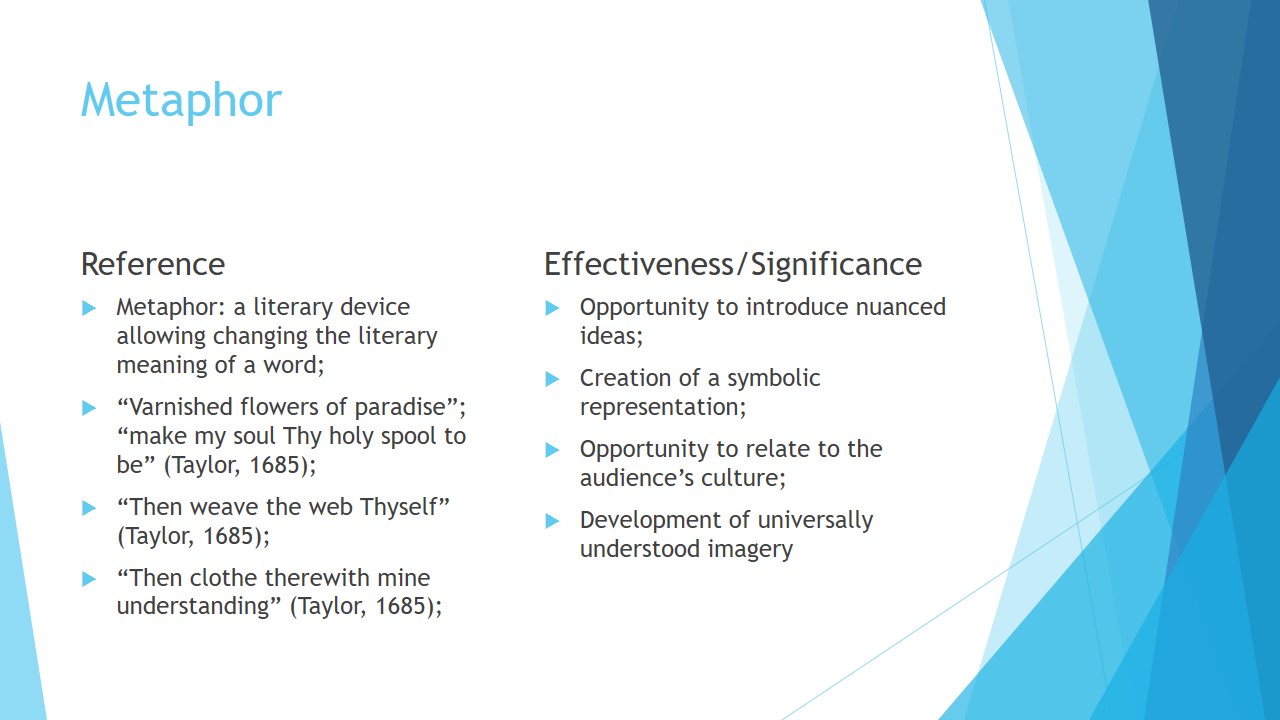
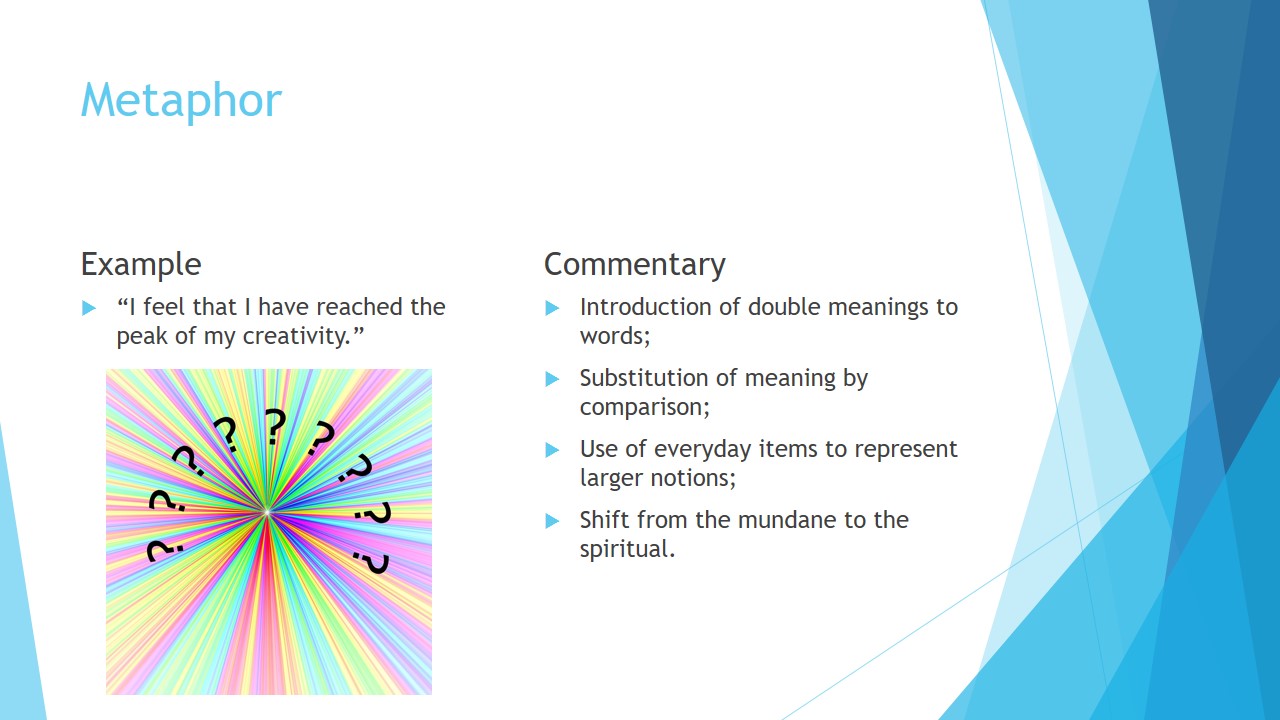
Captivity Narrative
- Reference:
- Author: Mary Rowlandson (1682);
- Text: “Narrative of the captivity and restoration of Mrs. Mary Rowlandson”;
- “Those (as I may say) ravenous beasts” (Rowlandson, 1682, p. 2);
- “The savageness and brutishness of this barbarous enemy” (Rowlandson, 1682, p. 3);
- “My master had three squaws” (Rowlandson, 1682, p. 6).
- Effectiveness/Significance:
- Promotion of the civilized versus the savage dichotomy;
- Introduction to the idea of conversion;
- Presence of strong colonialist ideas;
- Juxtaposition of the traditional values and the ones of the foreign culture.
- Example:
- “As I was captured by the savage race of Aamara, I was shocked at their brutality and the heathen nature of their traditions.”
- Commentary:
- Juxtaposition of the Christian culture and that one of local people;
- Negligence for the cultural needs of indigenous people;
- Combination of Christian philosophy and colonialism as a highly controversial choice.
Finally, the importance of the captivity narrative in literature must be explored. The subject matter is typically rendered as the story that describes being captured and trapped in the environment that is deemed as uncivilized by the victim. Therefore, the notion of the captivity narrative can be considered the direct effect of the colonialist nature of the Western narrative. The captivity narrative serves a major purpose in establishing the dichotomy of civilized Christians versus savages.
The example provided above points to the problematic nature of the captivity narrative. Although the specified tool helps to increase the emotional tension and reinforce the power of the intended message, it is built on the false premise of the superiority of one philosophy over another. Specifically, Rowlandson’s text represents the “Indians,” as they are referred to in the text, as savages and brutes. Specifically, the author mentions “the bloody heathen ready to knock us on the head” (Rowlandson, 1682, p. 1). However, the described position largely supports the false impression that one of the cultures is morally superior, which is a tremendously unfair and unethical statement.
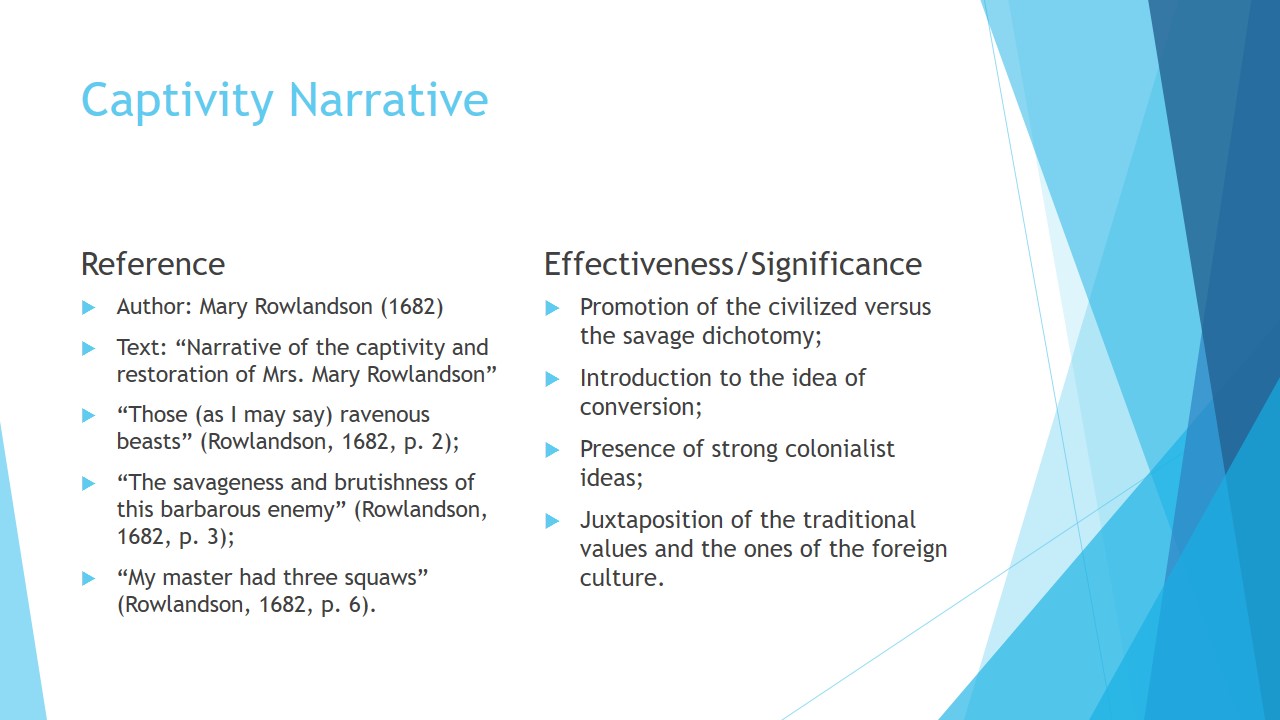
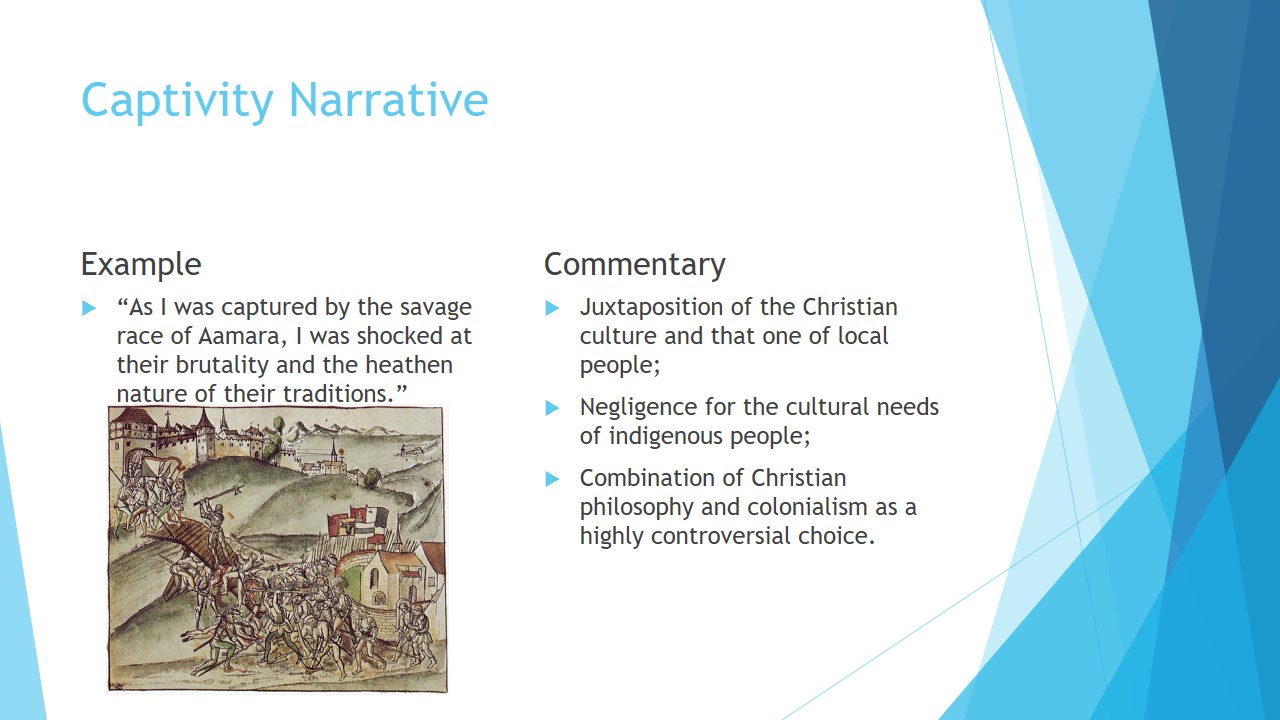
References
Bradford, W. (1630-1650). Of Plymouth Plantation excerpt. Web.
Bradstreet, A. (1666). Upon the burning of our house. Web.
Bradstreet, A. (1678). To my dear and loving husband. Web.
Edwards, J. (1741). Sinners in the hands of an angry God. Web.
Rowlandson, M. (1682). A narrative of the captivity and restoration of Mrs. Mary Rowlandson. Web.
Taylor, E. (1685). Huswifery. Web.
Winthrop, J. (1630). City upon a hill. Web.